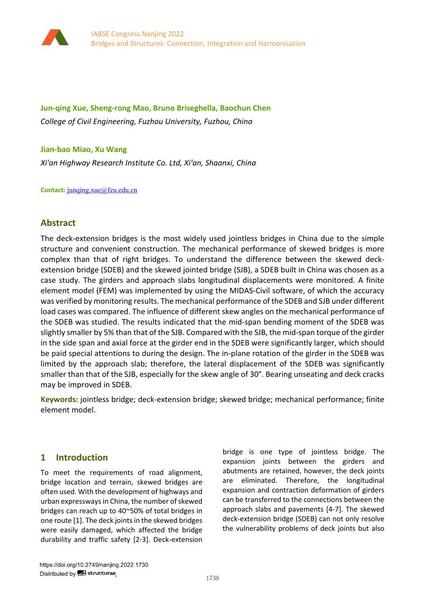Mechanical performance of skewed deck-extension bridge

|
|
|||||||||||
Bibliografische Angaben
| Autor(en): |
Jun-Qing Xue
(College of Civil Engineering, Fuzhou University, Fuzhou, China)
Sheng-rong Mao (College of Civil Engineering, Fuzhou University, Fuzhou, China) Bruno Briseghella Baochun Chen (College of Civil Engineering, Fuzhou University, Fuzhou, China) Jian-bao Miao (Xi''an Highway Research Institute Co. Ltd, Xi''an, Shaanxi, China) Xu Wang (Xi'an Highway Research Institute Co. Ltd, Xi'an, Shaanxi, China) |
||||
|---|---|---|---|---|---|
| Medium: | Tagungsbeitrag | ||||
| Sprache(n): | Englisch | ||||
| Tagung: | IABSE Congress: Bridges and Structures: Connection, Integration and Harmonisation, Nanjing, People's Republic of China, 21-23 September 2022 | ||||
| Veröffentlicht in: | IABSE Congress Nanjing 2022 | ||||
|
|||||
| Seite(n): | 1730-1738 | ||||
| Anzahl der Seiten (im PDF): | 9 | ||||
| DOI: | 10.2749/nanjing.2022.1730 | ||||
| Abstrakt: |
The deck-extension bridges is the most widely used jointless bridges in China due to the simple structure and convenient construction. The mechanical performance of skewed bridges is more complex than that of right bridges. To understand the difference between the skewed deck- extension bridge (SDEB) and the skewed jointed bridge (SJB), a SDEB built in China was chosen as a case study. The girders and approach slabs longitudinal displacements were monitored. A finite element model (FEM) was implemented by using the MIDAS-Civil software, of which the accuracy was verified by monitoring results. The mechanical performance of the SDEB and SJB under different load cases was compared. The influence of different skew angles on the mechanical performance of the SDEB was studied. The results indicated that the mid-span bending moment of the SDEB was slightly smaller by 5% than that of the SJB. Compared with the SJB, the mid-span torque of the girder in the side span and axial force at the girder end in the SDEB were significantly larger, which should be paid special attentions to during the design. The in-plane rotation of the girder in the SDEB was limited by the approach slab; therefore, the lateral displacement of the SDEB was significantly smaller than that of the SJB, especially for the skew angle of 30°. Bearing unseating and deck cracks may be improved in SDEB. |
||||
| Stichwörter: |
Finite-Elemente-Modell
|
||||
| Copyright: | © 2022 International Association for Bridge and Structural Engineering (IABSE) | ||||
| Lizenz: | Die Urheberrechte (Copyright) für dieses Werk sind rechtlich geschützt. Es darf nicht ohne die Zustimmung des Autors/der Autorin oder Rechteinhabers/-in weiter benutzt werden. |
||||

